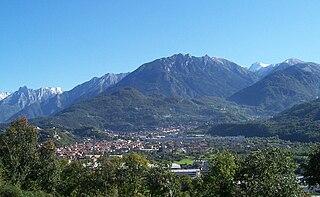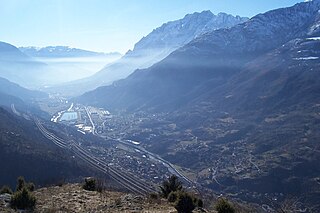Z
| Provinces and places | ||
|---|---|---|
| History | ||
| Politics and government | ||
| Education and culture | ||
This is a list of communes of the Italian province of Brescia.

The Province of Brescia is a Province in Lombardy, northern Italy. It has a population of some 1,265,325 and its capital is the city of Brescia.

Berzo Demo is an Italian comune in Val Camonica, province of Brescia, in Lombardy, northern Italy.

Berzo Inferiore is an Italian comune of 2,316 inhabitants in Val Camonica, province of Brescia, in Lombardy, northern Italy.

Calvagese della Riviera is one of the 206 municipalities of the Province of Brescia in the northern Italian region Lombardy. It is located some 10 kilometres (6 mi) west of Lake Garda and its population of 3,522 is divided between the centres of Calvagese itself, Carzago, and Mocasina. Further localities include Belvedere, Ponte Clisi and Terzago.

Lodrino is a village and comune in the province of Brescia, in Lombardy, Italy. Neighbouring communes are Casto, Marcheno, Marmentino, Pertica Alta and Tavernole sul Mella. It is situated between the Trompia valley and Val Sabbia.

Marcheno is a town and comune in the province of Brescia, in Lombardy. Neighbouring communes are Casto, Gardone Val Trompia, Lodrino, Lumezzane, Marone, Sarezzo, Tavernole sul Mella and Zone. It is located in the Trompia valley.

Pisogne is a comune of 8156 inhabitants in the province of Brescia, in Lombardy, Italy.

Lake Iseo or Iseo lake, also known as Sebino, is the fourth largest lake in Lombardy, Italy, fed by the Oglio river.

Sellero is a comune of 1,503 people in the province of Brescia in the middle Val Camonica.

Temù is an Italian comune of 1.113 inhabitants in the province of Brescia, in Lombardy, Italy.

Vestone is a comune in the province of Brescia, in Lombardy. It is situated on the river Chiese. Neighbouring communes are Barghe, Bione, Casto, Lavenone, Mura, Pertica Alta, Pertica Bassa, Preseglie, Provaglio Val Sabbia and Treviso Bresciano.
The Val Trompia is a slightly more than 50 km long valley in the Province of Brescia, northern Italy. It consists of the valleys of the river Mella and its tributaries, north of the city of Brescia. It is situated between Val Camonica, Val Sabbia and Lake Iseo.

The territory of Franciacorta, literally short France, is a section of the Province of Brescia in the Italian Region of Lombardy. Franciacorta extends from Mount Orfano on the southwest area to the shores of Lake Iseo, and from the river Oglio on the western border to the city of Brescia in the east. The geography of rolling hills was shaped by glacial action. The soil, glacial moraines consisting of gravel and sand over limestone, drains well, and is ideal for the cultivation of grapes and winemaking. The weather is mild and constant due to its location south of the foothills of the Alps and the tempering presence of large lakes. To publicize enotourism the district established a Strada del Vino Franciacorta on the model of the famed German Wine Route (Weinstraße) in 2001.

Val Camonica is one of the largest valleys of the central Alps, in eastern Lombardy, Italy. It extends about 90 kilometres (56 mi) from the Tonale Pass to Corna Trentapassi, in the commune of Pisogne near Lake Iseo. It has an area of about 1,335 km2 (515 sq mi) and 118,323 inhabitants.

The Oglio is a left-side tributary of the river Po in Lombardy, Italy. It is 280 kilometres (170 mi) long. In the hierarchy of the Po's tributaries, with its 280 kilometres (170 mi) of length, it occupies the 2nd place per length, while it is the 4th per basin surface, and the 3rd per average discharge at the mouth.
This is an alphabetical list of the 7,926 Italian comuni. These represent the fundamental municipal units of the local government system of the country.

Brescia railway station is the main station of Brescia, in the region of Lombardy, northern Italy. The station, opened in 1854, lies on the Milan-Venice railway and is a terminus of three branch lines: Valcamonica Railway to Edolo, Brescia-Lecco railway and Brescia-Piadena/Cremona railway which branches off towards southeast of the station.

The Garda Mountains, occasionally also the Garda Hills, are an extensive mountain range of the Southern Limestone Alps in northern Italy.

The Oldofredi were a noble Italian family, related to Pandolfo III Malatesta, originally from Manerbio. In the thirteenth century it drew strength and luck in the area Franciacorta and Lake Iseo, where he also owned a castle in Peschiera Maraglio island of Monte Isola, deriving the title from Ysé o Isei.